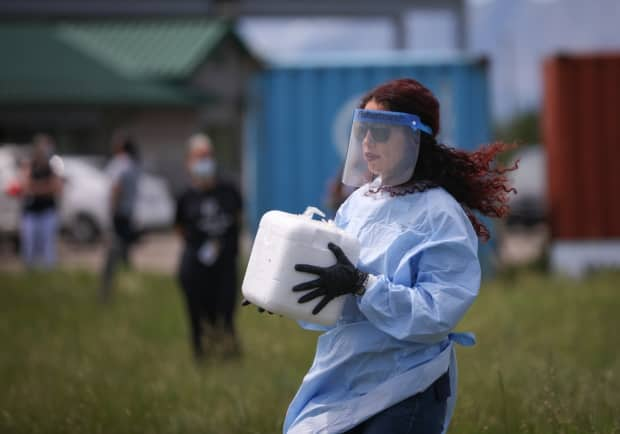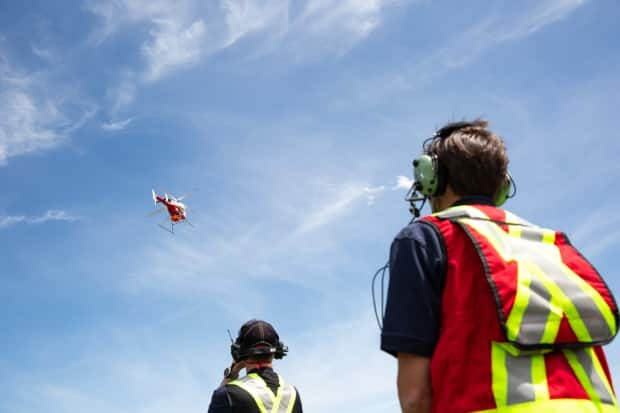Alberta researchers fly drones to remote Indigenous communities for COVID-19, medical help
In some remote parts of Alberta, getting a COVID-19 test or personal protective equipment isn't as simple as heading to a nearby store or testing facility.
So researchers are trying to bring tests and other medical help to the people — using drones.
Researchers from the University of Calgary, SAIT, Alberta Health and other agencies have partnered with the Stoney Nakoda Nation to finesse flight plans and procedures.

The shared goal is getting remote communities rapid COVID-19 testing.
That involves flying from the Foothills hospital, loaded up with PPE and testing kits, to the Stoney Nakoda reserve, then administering tests and delivering materials before flying the swabs to a lab for testing.
Wade Hawkins is the lead researcher at SAIT's Centre for Innovation and Research in Unmanned Systems (CIRUS).
Hawkins said he would like to fine-tune things to the point where this model could be used anywhere in Canada.
It's seen as a safe and more cost-effective way that could be deployed by communities themselves instead of using costly aircraft or helicopters.
He said the project is scaling up, starting with flights to accessible parts of the Stoney Nakoda Nation. Then the next goal is flying to more remote locations.
"Our reserve in Morley has multiple access points. However, our satellite reserves in Eden Valley and Big Horn are remote, and a delivery system using drones could play a critical role in the health and safety of our communities," said Ryan Robb, CEO of the Stoney Tribal Administration, in a prepared statement.
"Like many remote Canadian communities, weather can play a key role. For example, depending on the time of the year, ice roads and floods can create access barriers."

The concept seems simple, but it takes a lot of work to perfect.
In Canada, drone operators have to follow strict rules set out by Transport Canada. For the safety of those on the ground, and others in the air, flights can only operate within the sightlines of a pilot on the ground.
Hawkins said they have been testing out different metrics on battery life, fuel and flight paths to eventually seek permission from the federal agency and be able to safely fly beyond the line of sight.
Flights scheduled through winter
"It requires a lot of extra items to be able to support that operation safely," Hawkins said. "So, for example, we need to be able to ensure we have a detect-and-avoid system. So on our particular drone, we have to be able to sense surrounding aircraft to avoid them."
Hawkins said this work will continue through the winter, if their SwissDrones SDO 50 V2 helicopter can withstand the weather. With the continued work, and depending on Transport Canada's approval, he hopes to finish up this project next summer.
Dr. John Conly of the University of Calgary said they've successfully delivered RNA COVID-19 tests — which at this point don't contain the live virus — and returned them to the lab.
Tests viable for use
"There was no decay in the signal or the testing capabilities for these samples," Conly said.
Conly said it's exciting and helps prove the concept that this is a viable way to get medical supplies, even testing capacity, to remote locations.
He said they have even flown ultrasound devices out to test remote, supervised scans using the machine. The patient in this case is video chatting with a doctor either by satellite or wireless connection.
It shows there are many applications once the flights are perfected, Conly said.
"Could we do drone delivery of prescriptions or medications … particularly if there was inclement weather and someone had difficulty trying to navigate into a central site?" Conly said, "The sky's the limit in this respect, and I think it opens up many doors."

